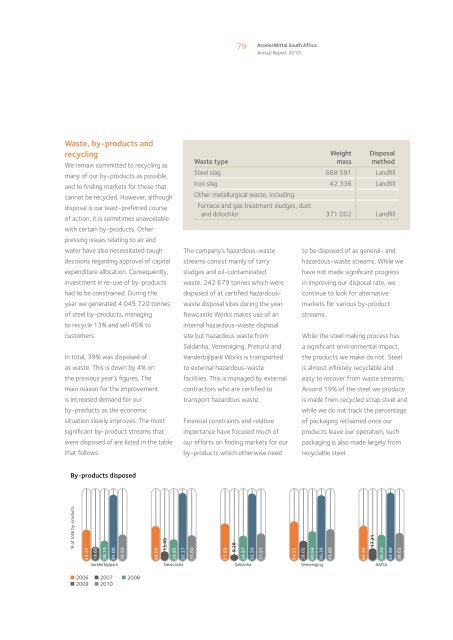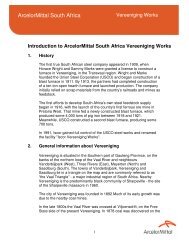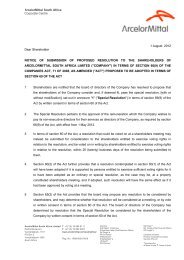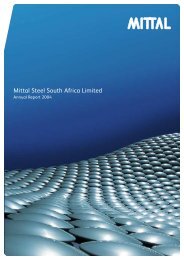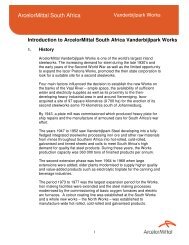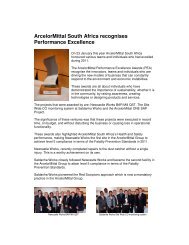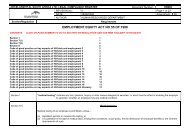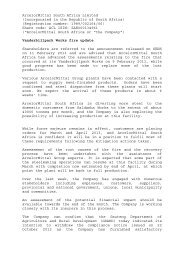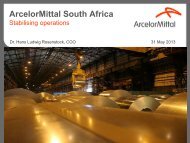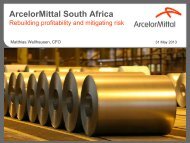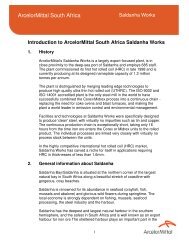bold spirit - ArcelorMittal South Africa
bold spirit - ArcelorMittal South Africa
bold spirit - ArcelorMittal South Africa
You also want an ePaper? Increase the reach of your titles
YUMPU automatically turns print PDFs into web optimized ePapers that Google loves.
79<br />
<strong>ArcelorMittal</strong> <strong>South</strong> <strong>Africa</strong><br />
Annual Report 2010<br />
Waste, by-products and<br />
recycling<br />
We remain committed to recycling as<br />
many of our by-products as possible,<br />
and to finding markets for those that<br />
cannot be recycled. However, although<br />
disposal is our least-preferred course<br />
of action, it is sometimes unavoidable<br />
with certain by-products. Other<br />
pressing issues relating to air and<br />
water have also necessitated tough<br />
decisions regarding approval of capital<br />
expenditure allocation. Consequently,<br />
investment in re-use of by-products<br />
had to be constrained. During the<br />
year we generated 4 045 720 tonnes<br />
of steel by-products, managing<br />
to recycle 13% and sell 45% to<br />
customers.<br />
In total, 39% was disposed of<br />
as waste. This is down by 4% on<br />
the previous year’s figures. The<br />
main reason for the improvement<br />
is increased demand for our<br />
by-products as the economic<br />
situation slowly improves. The most<br />
significant by-product streams that<br />
were disposed of are listed in the table<br />
that follows:<br />
Waste type<br />
Weight<br />
mass<br />
Disposal<br />
method<br />
Steel slag 668 591 Landfill<br />
Iron slag 42 336 Landfill<br />
Other metallurgical waste, including:<br />
Furnace and gas treatment sludges, dust<br />
and dolochlor 371 002 Landfill<br />
The company’s hazardous-waste<br />
streams consist mainly of tarry<br />
sludges and oil-contaminated<br />
waste, 242 679 tonnes which were<br />
disposed of at certified hazardouswaste<br />
disposal sites during the year.<br />
Newcastle Works makes use of an<br />
internal hazardous-waste disposal<br />
site but hazardous waste from<br />
Saldanha, Vereeniging, Pretoria and<br />
Vanderbijlpark Works is transported<br />
to external hazardous-waste<br />
facilities. This is managed by external<br />
contractors who are certified to<br />
transport hazardous waste.<br />
Financial constraints and relative<br />
importance have focused much of<br />
our efforts on finding markets for our<br />
by-products which otherwise need<br />
to be disposed of as general- and<br />
hazardous-waste streams. While we<br />
have not made significant progress<br />
in improving our disposal rate, we<br />
continue to look for alternative<br />
markets for various by-product<br />
streams.<br />
While the steel making process has<br />
a significant environmental impact,<br />
the products we make do not. Steel<br />
is almost infinitely recyclable and<br />
easy to recover from waste streams.<br />
Around 19% of the steel we produce<br />
is made from recycled scrap steel and<br />
while we do not track the percentage<br />
of packaging reclaimed once our<br />
products leave our operation, such<br />
packaging is also made largely from<br />
recyclable steel.<br />
By-products disposed<br />
% of total by-products<br />
43.20<br />
19.60<br />
28.10<br />
91.00<br />
36.50<br />
48.06<br />
13.49<br />
29.95<br />
93.27<br />
35.60<br />
51.68<br />
9.28<br />
34.97<br />
92.50<br />
37.97<br />
54.55<br />
28.02<br />
40.94<br />
90.36<br />
43.80<br />
48.40<br />
17.31<br />
36.20<br />
93.90<br />
38.62<br />
Vanderbijilpark<br />
Newcastle Saldanha Vereeniging AMSA<br />
2006 2007 2008<br />
2009 2010


